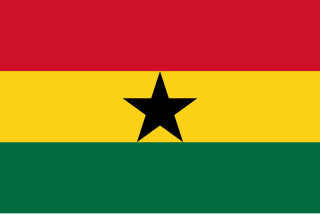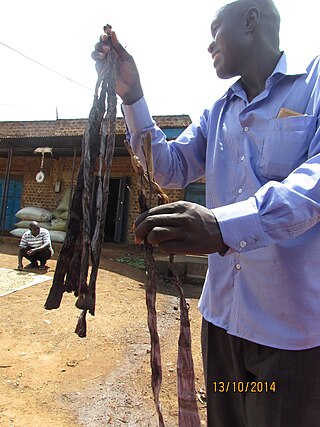
The peanut, also known as the groundnut, goober (US), goober pea, pindar (US) or monkey nut (UK), is a legume crop grown mainly for its edible seeds. It is widely grown in the tropics and subtropics by small and large commercial producers, both as grain legume and as an oil crop. Atypically among legumes, peanut pods develop underground leading botanist Carl Linnaeus to name peanuts hypogaea, which means "under the earth".

Peanut butter is a food paste or spread made from ground, dry-roasted peanuts. It commonly contains additional ingredients that modify the taste or texture, such as salt, sweeteners, or emulsifiers. Consumed in many countries, it is the most commonly used of the nut butters, a group that also includes cashew butter and almond butter.

Boiled peanuts are popular in some places where peanuts are common. Fully mature peanuts do not make good quality boiled peanuts; rather, raw or green ones are used. Raw denotes peanuts in a semi-mature state, having achieved full size but not being fully dried, as would be needed for roasting or peanut butter use. Green denotes freshly harvested and undried peanuts that must be refrigerated. After boiling in salt water they take on a strong salty taste, becoming softer with prolonged cooking, and somewhat resembling a pea or bean, to which they are related because they are legumes and a nut only in the culinary sense.

A purée is cooked food, usually vegetables, fruits or legumes, that has been ground, pressed, blended or sieved to the consistency of a creamy paste or liquid. Purées of specific foods are often known by specific names, e.g., apple sauce or hummus. The term is of French origin, where it meant in Old French purified or refined.

The cuisine of the Democratic Republic of the Congo and the Republic of the Congo varies widely, representing the food of indigenous people. Cassava, fufu, rice, plantain and potatoes are generally the staple foods eaten with other side dishes.

Ghanaian cuisine refers to the meals of the Ghanaian people. The main dishes of Ghana are centered around starchy staple foods, accompanied by either a sauce or soup as well as a source of protein. The primary ingredients for the vast majority of soups and stews are tomatoes, hot peppers, and onions. As a result of these main ingredients, most Ghanaian jollof rice, soups, and stews appear red or orange.

Burmese tofu is a food of Shan origin and of Chinese from Yunnan Province, made from water and flour ground from yellow split peas and the Burmese version of chickpea flour, also known as besan flour, in a fashion similar to polenta. The flour is mixed with water, turmeric, and a little salt and heated, stirring constantly, until it reaches a creamy consistency. It is then transferred into a tray and allowed to set. It can also be made using dried chickpea instead of processed flour. In this process, dried chickpeas are soaked overnight. Once the peas have been re-hydrated, they are ground into a puree with some of the liquid used to soak the peas, then allowed to set for a couple of hours. Much of the top layer of clear liquid is then skimmed off and the remaining puree is brought to a boil with turmeric and salt and cooked and set in the same manner as the version using chickpea flour. It is matte yellow in colour, jelly-like but firm in consistency, and does not crumble when cut or sliced. It may be eaten fresh as a Burmese tofu salad or deep-fried into a Burmese fritter. It may also be sliced and dried to make crackers for deep frying. Despite the name, Burmese tofu is unrelated to Chinese tofu, which is made from soy milk with added coagulants.

A great variety of cassava-based dishes are consumed in the regions where cassava is cultivated. Manihot esculenta is a woody shrub of the spurge family, Euphorbiaceae, native to South America, from Brazil, Paraguay and parts of the Andes.

Chadian cuisine is the cooking traditions, practices, foods and dishes associated with the Republic of Chad. Chadians use a medium variety of grains, vegetables, fruits and meats. Commonly consumed grains include millet, sorghum, and rice as staple foods. Commonly eaten vegetables include okra and cassava. A variety of fruits are also eaten. Meats include mutton, chicken, pork, goat, fish, lamb and beef. The day's main meal is typically consumed in the evening on a large communal plate, with men and women usually eating in separate areas. This meal is typically served on the ground upon a mat, with people sitting and eating around it.

Lugbara cuisine is one of the meals of East Africa and the ancient Lado Enclave. The Lugbara people of northwestern Uganda and northeastern DR Congo eat not only vegetable dishes, but also animals like goats, cows plus ope (guineafowls) and catch insects like onya for food which is called nyaka in the standard Lugbara language used in Arua. Cassava flour, sometimes mixed with millet or sorghum like posho or ugali, is the staple food and is called enya(sa) and accompanied with a range of soup dishes. Rice, yams, potatoes and matoke are also eaten. Below is a list of some of the Lugbara-styled delicacies found in West Nile Restaurants, Ariwara Town, Arua Park in Kampala and many homes or cafeterias that cherish traditional Lugbara cuisine.

A food paste is a semi-liquid colloidal suspension, emulsion, or aggregation used in food preparation or eaten directly as a spread. Pastes are often highly spicy or aromatic, are often prepared well in advance of actual usage, and are often made into a preserve for future use. Common pastes are some fruit preserves, curry pastes, and nut pastes. Purées are food pastes made from already cooked ingredients.

Malewa is smoked bamboo shoot which is dried for preservation. The bamboo trees grow in the wild in eastern Uganda around Mt. Elgon in the districts of Bududa, Sironko and Mbale.

Indo cuisine is a fusion cooking and cuisine tradition, mainly existing in Indonesia and the Netherlands, as well as Belgium, South Africa and Suriname. This cuisine characterized of fusion cuisine that consists of original Indonesian cuisine with Eurasian-influences—mainly Dutch, also Portuguese, Spanish, French and British—and vice versa. Nowaday, not only Indo people consume Indo cuisine, but also Indonesians and Dutch people.

Sombe also known as Cassava leaves stew is a type of stew native to the Bakonzo in Uganda and also in the Eastern DRC, Burudians, Banyarwanda. It is traditionally made from freshly mashed cassava leaves as the main ingredient mixed with either fish or ground nuts paste or any type of meat such as beef, goat's meet, pork. Sombe is served majorly with Bundu (also known as mingled Tapioca, Kalo, fufu but it can also be served with rice, posho, matooke, Ggonja.

Firinda is a Ugandan sauce, made from uncoated mashed beans that originates from Western Uganda among the Batooro, Banyoro and Bakonzo. It is also known as Madakwa by the Congolese. It is a sauce that symbolises hospitality, served at different occasions including traditional marriage ceremonies, restaurants and cultural rituals.















